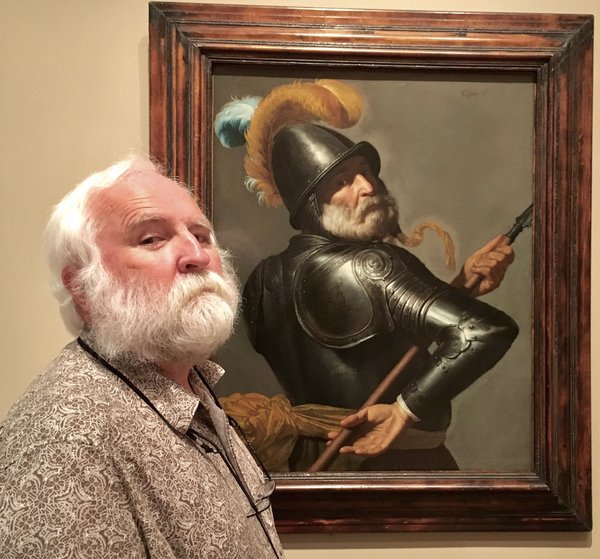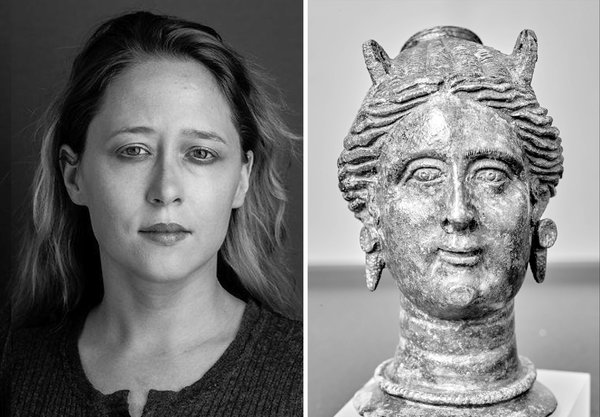Advertisement
Supported by

Jan. 17, 2018
Ross W. Duffin was wandering through a museum in Pasadena, Calif., last summer when he paused before a 17th-century painting of a bearded warrior in armor.
“I thought, ‘Wow, that is really funny, he looks just like me,’” Dr. Duffin recalled. Then he moved on.
But his wife, Beverly Simmons, was stunned by the resemblance. “She came running after me and said, ‘You have to come back and look at this painting!” Dr. Duffin said.
Dr. Duffin had found his art twin. So the couple did what millions of people have discovered as a new way to interact with art — something that has exploded with new popularity in recent weeks thanks to a new feature in a Google museums app.
But Dr. Duffin and his wife were pioneers last summer, using old-fashioned serendipity. He stood next to the oil painting, a work by the Dutch artist Jan van Bijlert displayed at the Norton Simon Museum. He turned sideways, raised his chin and narrowed his eyes. His wife captured the moment with her iPhone.
Long before the Google Arts and Culture app, which became the most downloaded mobile app over the weekend, art aficionados, dabblers, narcissists and soul searchers pondering a cosmic connection to distant humans have been searching for their art twins, a long-gone, sometimes fictional or unknown doppelgänger encased in oil, sculpture or ceramics.
Some set out specifically to find their twin, in an engaging pastime that gives museum visits a new focus. Others, like the Duffins, have stumbled on theirs as they wander.
As anyone who regularly looks at a social media feed knows by now, millions more need never leave home or cross a border to find that uniquely familiar face on some obscure etching. They just upload a selfie and let technology do the sleuthing.
The app was available in 2015, but its arts matching feature was introduced in mid-December. Its popularity has quickly surged, and Instagram, Twitter and YouTube users have widely shared photos of both their art twins and those of celebrities, from William Shatner to Taylor Swift. Google estimates more than 20 million selfies have been uploaded using the new feature.
Dr. Duffin said he was amused by his moment with the unknown soldier, described by the museum as probably a more mythological than human figure. But the resemblance had an impact on his life after he posted the photograph on Twitter, where it was widely shared without identifying him by name.
“A month later, all of a sudden, it started to get a lot of play in the press,” Dr. Duffin, a professor of music at Case Western Reserve University in Cleveland, said in an interview. “I would get email messages from people I had not heard from in years who knew immediately it was me.”
With people seeking selfies that make a connection going back in time, museums are using the opportunity to engage with visitors.

Leslie C. Denk, a spokeswoman for the Norton Simon Museum, said the museum had noticed some visitors posting photographs of themselves posing like works of art, particularly alongside sculptures by Auguste Rodin and Aristide Maillol.
“Art has the power to transport us through time, and so I think it’s a joy to recognize ourselves, a friend or even a pet, in an artwork from centuries ago,” she said.
Art-twinning happens so often in the Museum of Fine Arts in Boston that it hosts a fan favorite every week on Instagram. The most popular piece to pose with is “Little Fourteen-Year-Old Dancer,” a sculpture by Edgar Degas.
“In our galleries, visitors frequently seek out their museum doppelgänger or attempt to mimic works of art — usually as they search for the perfect Instagram shot,” said Katie Getchell, the deputy director and chief brand officer at the Boston museum.
At the Brooklyn Museum, selfies with artworks are also popular. “The success of Google’s project comes as no surprise to me, or probably to anyone else who works in a museum,” said Brooke Baldeschwiler, the museum’s senior manager of digital communications. “It’s really simple. People love to see themselves in art.”
https://twitter.com/itssierrarenee/status/952709725325578240
https://twitter.com/brooklynmuseum/status/953122266853847040
If human beings are obsessed with selfies, then the Google Arts and Culture app is the addiction’s enabler for the art world. It does have its critics. Some people just find facial recognition software creepy, and the app is not available in Texas and Illinois, which have some of the country’s strictest laws about the collection of biometric data, including selfies. The app also has mixed results, particularly when it comes to race, gender and age.
“My grandmother got Ronald Reagan’s presidential portrait,” said Patrick Lenihan, a spokesman for Google.
Far from the virtual realm, Greco-Roman antiquities, Egyptian funerary portraits and the contemporary people who resemble them are being brought together in an exhibit in Canada called “My 2,000-Year-Old Double.”
The Musée de la Civilisation in Quebec City has narrowed down thousands of selfies to a few dozen people who resemble the artworks, arranging for them to be photographed in Montreal by François Brunelle, whose previous projects include documenting people who look alike but are not twins.
Wesley Rowell, 57, who works in New York City, was one of them.
He will appear alongside his art twin, a sculpture of an unidentified man from the third century B.C.
“To think about the lives, the generations, between him and me in New York City, is kind of bizarre,” Mr. Rowell said. “I keep going back to that human need, to feel like I am connected to everything that was before me.”
Amanda Bullis, 29, an actor who lives in Jersey City, was chosen for her similarity to a face carved onto a vessel, dating between 300 and 201 B.C.

Ms. Bullis sat for hours for hair and makeup. “In that moment I was able to embody her,” she said, adding that it made her think about her ancestry. “I just found it interesting that I am part of a larger humanity that has been evolving and changing, but largely the same, over thousands of years.”
Dr. Duffin, the Ohio professor, said he did not think much more about his art twin after he posed with the painting in California. He is accustomed, he added, to being mistaken for another bearded fellow.
Strangers often ask him, “Has anyone ever told you that you look like Santa Claus?” he said. “And my answer is, ‘Not since yesterday.’”
Sign up for the Louder Newsletter
Please verify you’re not a robot by clicking the box.
Invalid email address. Please re-enter.
You must select a newsletter to subscribe to.
* Required field
Thank you for subscribing.
View all New York Times newsletters.
An error has occurred. Please try again later.
You are already subscribed to this email.
View all New York Times newsletters.
Advertisement
Article source: https://www.nytimes.com/2018/01/17/arts/google-art-selfies-doppelgangers.html?partner=rss&emc=rss
Speak Your Mind
You must be logged in to post a comment.